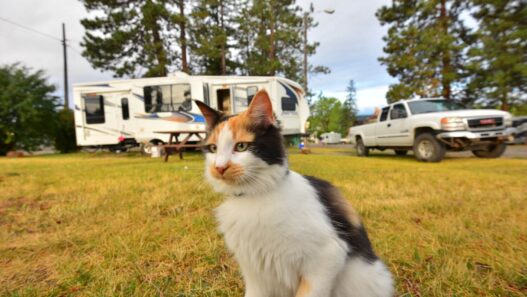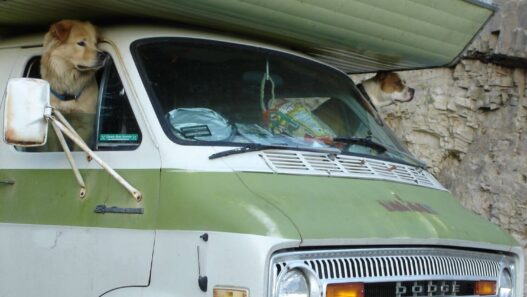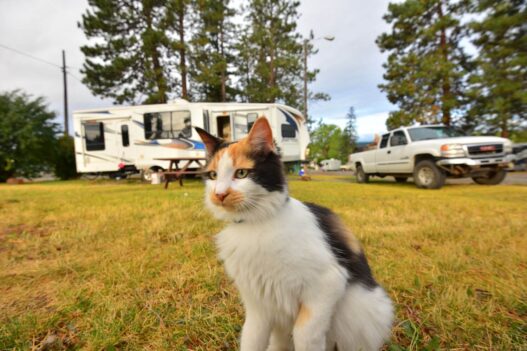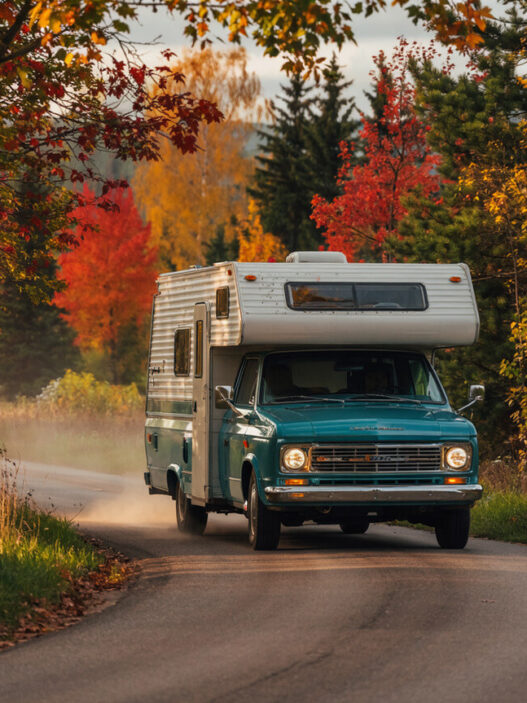Taking your cat friend on RV adventures can be an amazing experience with the right preparation. These tips will help make life on the road comfortable and enjoyable for both you and your cat!
1. Let Your Cat Check Out The RV First
Cats need time to feel comfortable in new spaces. Park your RV at home and bring your cat inside for short visits before any trips. Put their favorite bed or blanket inside so they have something familiar. Let them sniff around, explore cabinets, and get used to the strange new space while it stays perfectly still.
Do this several times over a few days or weeks before your first trip. Some cats adjust quickly while others need more time to accept this weird moving home.
2. Keep Trips Short At First
Just like people, cats need to get their “travel legs.” Start with super short drives just around your neighborhood or to a nearby park. Maybe 15-30 minutes tops. This helps your cat learn that the scary moving house eventually stops, and everything turns out okay.
Once they seem less stressed during these mini trips, gradually make your adventures longer. Rushing into a weekend trip before your cat is ready can create a miserable experience for everyone.
3. Keep Your Cat Safe While Driving
Never let your cat roam freely while driving. A scared or curious cat might jump on the dashboard, crawl under the brake pedal, or hide somewhere dangerous. Use a secure carrier or special cat harness attached to a seatbelt. In motorhomes, some people create a secure cat area away from the driver with access to water and a litter box.
Whatever setup you choose, make sure your cat cannot reach the driver or escape if a door opens.
4. Pack Their Favorite Stuff
Cats find comfort in familiar smells and objects. Bring their regular bed, favorite toys, and even that ratty blanket they love to knead. These items carry scents from home that help reduce stress in the new environment. Try not to wash these items right before the trip so they keep their homey smell.
Having familiar objects around helps convince your cat that although the scenery outside changes, their personal territory remains somewhat the same.
5. Make Cozy Hideaways
Cats naturally seek small, enclosed spaces when they feel threatened or overwhelmed. Create secure hiding spots throughout your RV where your cat can retreat when they feel anxious. This might be under the bed, in a cabinet with the door slightly propped open, or in a cat bed with high sides.
Make sure these spots will not shift during travel or allow your cat to become trapped. Many RVers notice their cats have different hiding preferences for when the vehicle is moving versus when it is parked.
6. Make Your RV Cat-Friendly
Adding some special cat features to your RV creates a space your feline will actually enjoy. Install a small scratching post or pad where they can stretch and mark territory. Create perches near windows where they can watch the world go by. Consider a suction cup bird feeder outside a window for endless entertainment.
Some RV cats enjoy hammocks attached to windows or small cat tunnels that provide both hiding spots and play areas. The more cat-friendly elements you include, the more your cat will see the RV as their territory rather than a scary box.
7. Find A Good Spot For The Litter Box
The litter box location requires careful thought in an RV. It needs to be accessible for your cat but not in the way of human activities. Popular spots include inside the shower stall when not in use, under a modified bench seat, or in a storage compartment accessed through a custom cat door.
Some RVers build special cabinets with ventilation just for this purpose. Wherever you put it, make sure your cat can always reach it, even during travel if possible. Also consider splurge-worthy odor control litter for the small space.
8. Keep Food And Water From Spilling
Regular pet dishes spell disaster on travel days. Instead, use spill-proof bowls or dishes that attach securely to a wall or inside a cabinet. Some RVers create a special feeding station that closes up during travel days. For water, consider a small pet fountain with a large reservoir that reduces splashing and encourages drinking.
Remember that many cats drink less while traveling due to stress, so monitor their water intake and consider adding wet food to their diet for extra hydration.
9. Let Them Roam In The Motorhome
If you have a motorhome, your cat might eventually graduate to having limited freedom while driving. This works best for confident cats who have already adapted well to RV life. Start by letting them out of their carrier for just a few minutes while someone watches them carefully. Gradually increase freedom as they demonstrate calm behavior. Always have a safe space ready where they can be secured if they show signs of panic or get in the way of driving controls.
Many cats eventually find a favorite spot where they nap through most of the journey.
10. Stick With Their Regular Food
A camping trip is no time to try new cat food. Stick with exactly what your cat eats at home to avoid tummy troubles on the road. Pack extra food in case of delays or if stores at your destination do not carry their brand. Some cats eat less during travel due to stress, so extra tasty wet food can help maintain nutrition.
Keep treats handy too, as they can help create positive associations with different aspects of RV life and coax a nervous cat out from hiding when needed.
11. Get Them Used To A Harness
Many RV cats enjoy supervised outdoor time at campsites, but they need proper safety gear. Introduce a harness at home weeks before your trip. Start by just showing it to your cat with treats, then briefly placing it nearby during feeding. Work up to very short wearing sessions with lots of treats and praise. Gradually increase wearing time until your cat moves normally while harnessed.
Only then add a lightweight leash. Never use retractable leashes as they provide less control and can allow cats to climb trees or dart under the RV if startled.
12. Think About Poop (Yes, Really)
Cat waste management matters even more in tiny spaces. Consider a higher quality cat food that produces less waste and firmer stools that are easier to scoop. Clumping litter usually works best for travel. Bring a small vacuum for scattered litter and consider litter mats that trap particles from paws. Some RVers swear by covered boxes or top-entry litter boxes to contain scatter.
Empty the box more frequently than at home to control odors in the small space. Storing used litter in scent-controlling bags until you reach a proper disposal site keeps everyone happier.
13. Give Them A Window With Privacy
Cats love watching the world, but they also like feeling hidden. Create window spots where your cat can observe outside activity while feeling somewhat concealed. Window perches with slight sides work well. For dashboard lounging, partial sunshades can create the perfect balance of visibility and security.
Some cats prefer elevated viewpoints like the top of the couch near a window. Notice which windows your cat gravitates toward and enhance those areas with comfortable padding or better access routes.
14. Don’t Expect Purrs Right Away
Cats rarely love big changes immediately. Your cat might hide, refuse treats, eat less, or cry more during the first few RV experiences. This is normal adjustment behavior. Stay patient and maintain a calm environment without forcing interaction. Follow their usual routine as much as possible with regular feeding times and play sessions when they seem ready. Most cats show improvement with each trip as they learn the patterns of RV life.
Given enough positive experiences, many cats eventually become enthusiastic travelers who recognize the RV as a second home.
15. Watch The Doors And Windows
Cats can squeeze through surprisingly small openings, especially when motivated by fear or curiosity. Always know where your cat is before opening doors. Consider installing screen door protectors as claws easily tear through standard screens. Some RVers add an extra safety step like a pet gate near the main door.
Also check around dashboard areas, vents, and storage compartments for unexpected access points. Remember that an escaped cat in an unfamiliar location can be extremely difficult to recover, so prevention matters tremendously.
16. Look Out For Wildlife
The great outdoors presents various threats to cats, even with supervision. Be aware of your surroundings when allowing cats outside on harnesses. Watch for loose dogs at campgrounds, wildlife like coyotes or birds of prey, and even small dangers like ticks or poisonous plants. Choose your outdoor time carefully based on location risks and weather conditions.
Morning or evening usually offers safer temperatures and fewer disturbances from neighbors or wildlife. Always maintain physical control of the leash rather than tying it to something that your cat could escape from if startled.
17. Know Some Pet First Aid
Remote camping spots often sit far from veterinary care. Learn basic cat first aid and assemble a pet-specific kit. Include items like styptic powder for broken claws, tweezers for splinter or tick removal, a digital thermometer, and any medications your cat takes regularly. Save contact information for emergency vets along your planned route and download pet first aid apps that work offline.
Consider investing in a pet microchip with updated information and bring recent photos of your cat in case they get lost. Some RVers also carry a small pet carrier that works well for emergency transport.

















